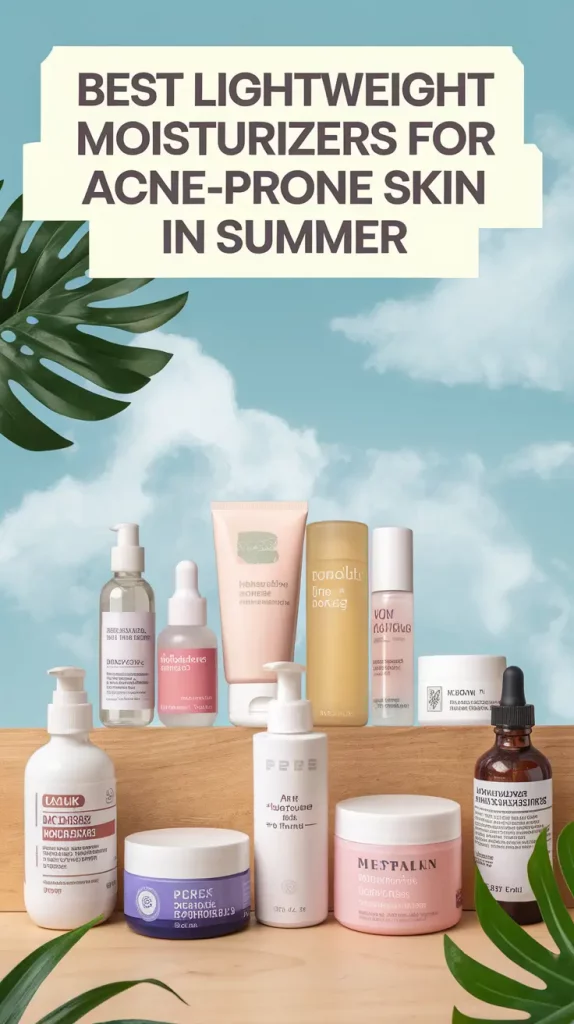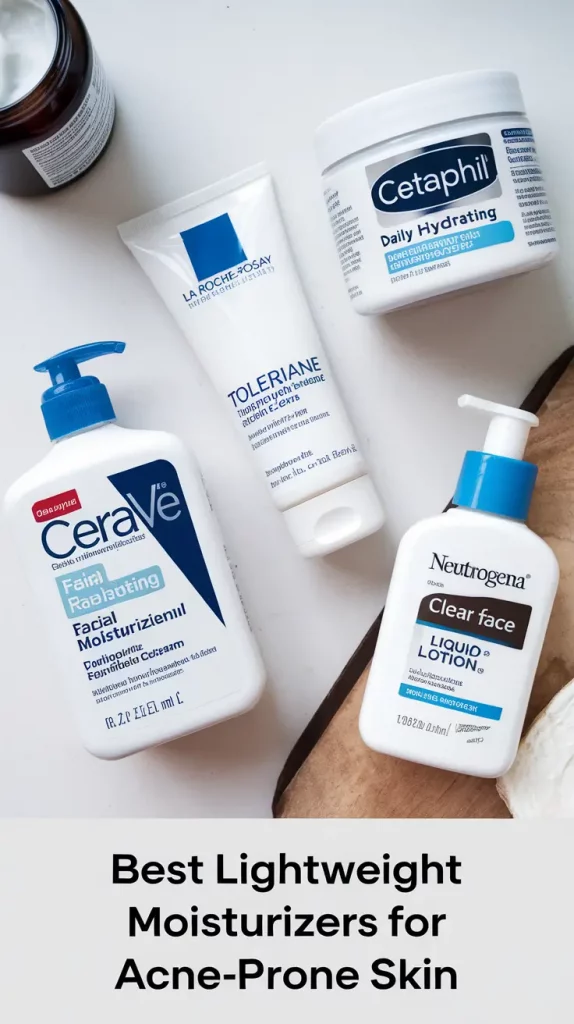Best Lightweight Moisturizers for Acne-Prone Skin in Summer
Every summer, like clockwork, my skin turns on me. The first warm day hits, and suddenly my go-to moisturizer feels like a sticky layer I can’t wait to wash off. I didn’t think much of it until the breakouts started to appear.
These are the ones: little, annoying and they arrive just as the weather gets warmer. The more I drank water, the more my symptoms increased. Turns out, summer skincare isn’t just about doing less — it’s about doing it smarter.
In this post, I’m going to show you how I took care of my acne-prone skin during the summer weather. What made the difference were the ingredients and the textures and this is what I’ll stick with, not what I’ll go back to.

Why Summer Skincare Needs Its Own Rules
Here’s what I didn’t expect…
The weather changed, and I thought I could keep the same moisturizer I’d used all winter. After just a week of hot weather and a glossy T-zone, I knew my plan wasn’t going well.
Your skin changes — so your routine should, too
When it’s hot out, our sebaceous glands go into overdrive. More oil, more sweat, more buildup. Heavy creams can actually cause acne for people with acne-prone skin. You need to keep your summer skin hydrated, but with something that won’t clog your pores.
I didn’t decide to use a lightweight formula to avoid doing my usual routine. It was about using the right product for the season.
What to Look for in a Summer Moisturizer for Acne-Prone Skin
This is where it all shifted.
After giving up on trying to look dewy and focusing on balance, everything was different. I read what was in every product and made a list of what I needed. Literally.
What I look for now (and why you should too):
- Oil-free and non-comedogenic
Anything with mineral oil or coconut oil? Off the list. - Gel or water-based texture
Feels like nothing, absorbs in seconds. - Ingredients that calm
Niacinamide, green tea, panthenol — they soothe redness and reduce inflammation. - Bonus points for niacinamide
It’s been a game changer for my skin — helps regulate oil and minimize post-breakout marks.
And what I avoid, no matter the hype:
- Heavy emollients like lanolin or shea butter
Great for dry skin, not great for clogged pores. - Fragrances and alcohols
Too drying or irritating for reactive skin. - Shimmer or “glow-boosting” creams
On my oily skin, that just reads as sweaty.
The 3 Moisturizers That Actually Worked for Me
This was the real test — trying, breaking out, learning, and trying again. After weeks of testing, these are the three that made it into my actual routine. Not just hype — actual skin-approved favorites.
1. La Roche-Posay Effaclar Mat
Where matte meets moisture.
- Texture: Lightweight lotion
- Key ingredients: Sebulyse (for oil control), niacinamide
- Finish: Matte, smooth
- My take: I reach for this on those humid days when my skin feels slick before I even apply SPF. It holds up under makeup, which is rare.
Con: It’s not the most hydrating, so I skip it on days I’m feeling dry.
2. Neutrogena Hydro Boost Water Gel
Like a glass of cold water for your face.
- Texture: Bouncy gel
- Key ingredients: Hyaluronic acid
- Finish: Dewy but not greasy
- My take: I love how it disappears into my skin. On rushed mornings, this one gives me hydration without the wait.
Con: Doesn’t calm redness much — I still pair it with a calming serum.

3. CeraVe AM Facial Moisturizing Lotion with SPF 30
Double-duty done right.
- Texture: Cream-lotion hybrid
- Key ingredients: Niacinamide, ceramides, SPF
- Finish: Natural
- My take: When I’m too tired for a multi-step routine, this is my go-to. It does enough — even on breakout days.
Con: Leaves a slight white cast at first (but fades after a minute).
How I Finally Found My Ideal Match: A 3-Step Reset
You don’t need a 10-step routine. Sometimes, what your skin really needs is space to reset. This is the approach that worked for me.
3 steps that changed everything:
- Strip it back
I stopped using everything but cleanser and SPF for 5 days. No toners, no actives, no moisturizers. Just to listen to my skin. - Introduce one new moisturizer
I tried a new formula solo for a full week — no makeup on most days. I wanted to feel how it wore, not just how it looked. - Test with SPF and makeup
The final step: Would it hold up under my real routine? This part helped me filter out products that pilled, clashed with sunscreen, or made my skin oilier.
If you’ve ever felt stuck in your skincare — try this.
Let’s Compare: What Works for What Skin
Here’s a quick breakdown of what I found when I tested these moisturizers. If you’re unsure what will work for your summer skin, this might help:
| Product | Best For | Texture | Key Benefit | My Skin Reaction |
|---|---|---|---|---|
| Effaclar Mat | Oily, breakout-prone | Lotion | Oil control | Smooth finish, fewer breakouts |
| Hydro Boost | Dehydrated, combination | Gel | Intense hydration | Lightweight, non-irritating |
| CeraVe AM | Normal to combo | Cream | Hydration + SPF | Balanced skin, zero irritation |
This is the table I wish I had when I started.
Things I Wish I Knew Sooner
Here’s a hard truth: sometimes we sabotage our skin with the right product at the wrong time. Moisturizers are a perfect example. These small adjustments made the biggest difference.
What I had to unlearn:
- One moisturizer for all seasons? Doesn’t exist.
- “Rich” doesn’t mean “hydrating” — sometimes it means “pore-clogging.”
- If your skin feels greasy 20 minutes after moisturizing, something’s off.
What I started paying attention to:
- How my skin felt 30 minutes later — not just immediately.
- The finish — did it sit on top of my skin or sink in?
- How it layered with SPF and makeup — or didn’t.
Learning to notice those details helped me stop wasting money — and time.
How to Choose Yours (Even if You’re Starting From Scratch)
You don’t need to try 10 products. You just need to know what you’re looking for. Here’s a simple framework that helped me feel less overwhelmed:
👉 Checklist for shopping:
✔️ Does it say “non-comedogenic”?
✔️ Are water or glycerin the first few ingredients?
✔️ Is the texture described as gel, fluid, or lightweight lotion?
✔️ Any bonus ingredients (niacinamide, panthenol, green tea)?
❌ Any comedogenic oils, heavy butters, or fragrance high up in the list?
If a product meets 3 out of 4 criteria — it’s worth giving it a go.
A Final Note from My Skincare Shelf
When you have acne-prone skin in summer, you don’t need to follow the latest trends in moisturizers. You should listen to your skin, the climate and what you need.
What worked for me might not work for you. But I hope this gave you a roadmap. If nothing else, it should make you stop and check the label before buying anything else.
Because yes, your skin does deserve better — even when it’s hot, sweaty, and confused.
Pin this if you’re planning your summer skincare switch.
And tell me — what’s one moisturizer you actually loved in the heat?

